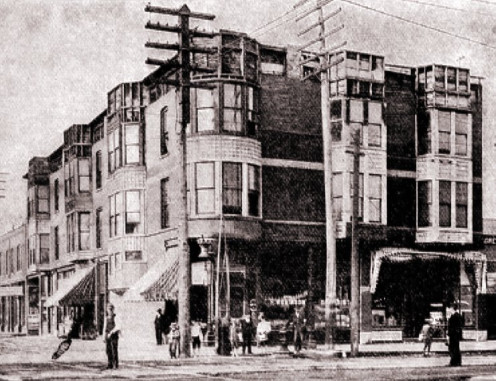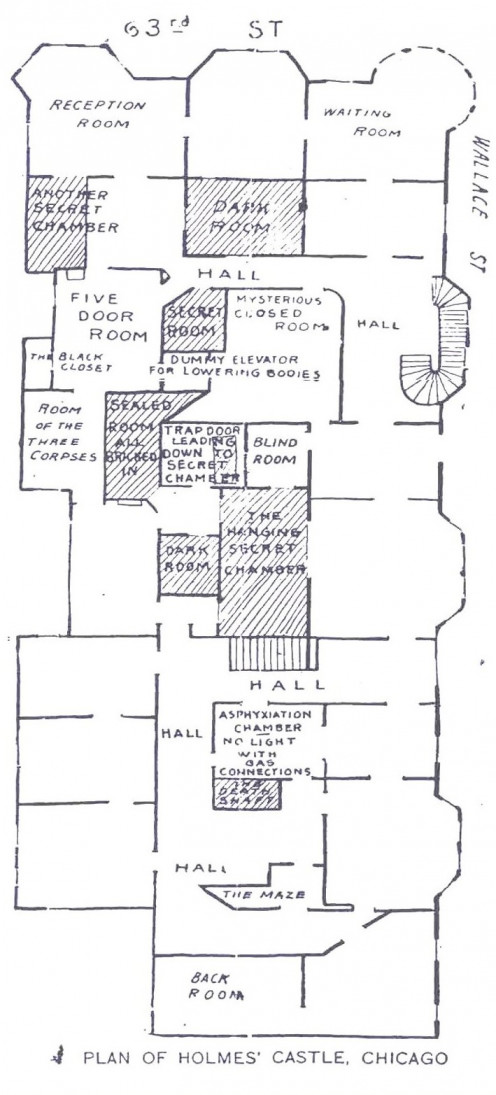America's First Documented Serial Killer
Dr. Henry Howard Holmes

America's First Well Documented Serial Killer
Herman Webster Mudgett, better known under the alias of Dr. Henry Howard Holmes, was one of the first documented serial killers in America. It is believed that he may have killed as many as 200 people around the U.S. Most of the victims were killed in Chicago.
There are several confessions from the doctor over the years; none that admitted to the same number of murders. In a confession for The Philadelphia Inquirer, he admitted to killing over one hundred people. In 1896 while he awaited execution, Holmes admitted to murdering 27 people in his infamous castle. On May 7, 1896, while on the gallows, he claimed he had only slain two people.
His “castle” was located at 63rd and Wallace Street in Chicago. It was a three-story building with shops on the first floor. The shops contained offices, a collection of turrets and bay windows, and Holmes's living quarters. The castle had false floors, secret passages, trapdoors, hallways that went in circles, rooms with torture equipment, soundproof rooms that could not be unlocked from the inside, and chutes in different parts of the house that led to the basement. The basement had a cremation oven located in it as well as several lime pits where it is assumed that the doctor would dispose of any evidence. Apparently, Holmes changed contractors several times, while the house was being built; so that no one could get a clear idea of what was being constructed, a “murder hotel”.
Holmes’ went to medical school at the University of Michigan in Ann Arbor and graduated in 1885. While there he learned how to use the corpses to defraud life insurance companies. He would use acid to obliterate the corpse’s features and then giving them the fictitious names. Once done, he claimed that the people were killed accidentally in order to collect insurance money from policies he took out. For awhile Holmes’ had an accomplice by the name of Ben Pietzel. The two of them concocted a scheme to defraud another insurance company by faking Pitezel’s death. Pietzel purchased a $10,000 life insurance policy with Fidelity Mutual Life Association. And Holmes’ and one of Pietzel’s children identified the body. Three of Pietzel’s children were kidnapped by Holmes and were later killed, as was their father.
Holmes was a handsome, intelligent man of great personal charm. By 1888, he had already been known to marry two women and abandoned them. While living in Chicago, he began working at a drug store, owned by a Dr. Holton. When Holton passed away he left his business to his widow. Not knowing how to manage the business, she offered to sell it to Holmes. It seems that Holmes never paid the poor widow any money towards the business. And after a few months of nonpayment the widow filed a lawsuit against him. Shortly after, the widow “disappeared” and the business was awarded to Holmes.
Many other people who were close to the good doctor “disappeared” as well. In 1890, Holmes hired Ned Connor as a watchmaker and jeweler. Connor and his family moved into an apartment above the store. After Conner suspected that Holmes and Julia were having an affair, he left his family and moved away. Holmes took out large insurance policies on her and her daughter and named himself as their beneficiary. Sometime later Connor’s wife and her daughter were killed with chloroform.
In 1892, Holmes began renting out rooms to tourist who were attending the Columbian Exposition. He also began hiring lots of young women. His employees were instructed to keep the location and the name of his company a secret. He told them it was necessary to prevent competitors from stealing clients. After murdering who knows how many people at his “death mansion”. Holmes decided to leave Chicago and travel the world, killing people along the way.
He was finally caught in 1895 by the Philadelphia police when he neglected to dispose of a body. Working together with the Chicago police, they finally got enough evidence to convict him. On May 7, 1896, Holmes was hanged at the Philadelphia County Prison. As a side note, within a few years of his death a great number of people associated with the case died suddenly; most of them under unexplained circumstances. The castle burned down on August 19, 1895. The cause of the fire was never determined.
Holmes' Castle in Chicago

Floorplans Of The 1st Floor of the "Murder Castle"

The Three Pietzel Children

Newspaper clipping









